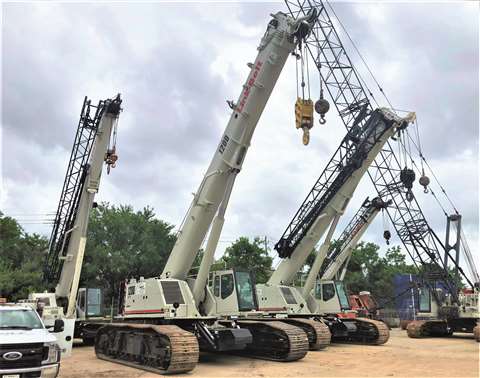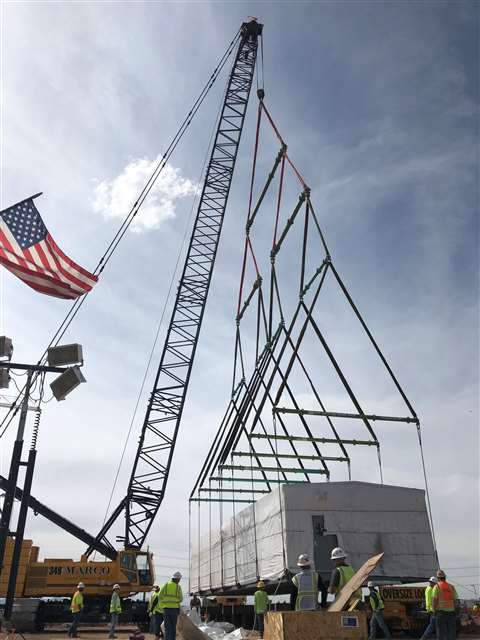Used crane demand indicates marketplace recovery
08 July 2021
The driving force for buying a used crane is price and availability.
It’s safe to say the market for used cranes is hot and getting hotter. As the economy beings to recover from the effects of the Covid-19 pandemic, construction is resuming and contractors are tackling projects with a new tenacity. As developments across the nation begin to see momentum, American Cranes & Transport spoke with David Worsham, general manager of Holt Crane & Equipment and Danny Mardian, sales manager, Mardian Equipment/Marco Crane about the market and its indicators. Mardian said there is a continued demand for used cranes, which he says is “hopefully” an indicator of a booming economy and will translate into replacing older equipment fleets with new machines.
 Used cranes have somewhat of a fixed cost. They were purchased pre-pandemic and for the most part have been underutilized over the past year. As a result, many used cranes have lower hours-usage than normal.
Used cranes have somewhat of a fixed cost. They were purchased pre-pandemic and for the most part have been underutilized over the past year. As a result, many used cranes have lower hours-usage than normal.
While both had very interesting takes on the demand to come, Worsham and Mardian are optimistic as fleets continue to grow and infrastructure projects begin to make a comeback. Worsham even expects to see an equipment shortage in the final quarters of 2021. Keep reading to find out more.
How would you describe the current market for used cranes?
WORSHAM: Holt Crane & Equipment is the Link-Belt crane dealer for a large portion of Texas. Although we occasionally follow our customers out of the state as well as seek out of state opportunities, we predominantly work here in the state of Texas. The Texas construction market, like many others, has been suppressed for the past year due to the pandemic. As the state beings to reopen and tries to return to some sense of normalcy, the Texas construction market and workforce is also trying to keep up. So as the market surges back, so too are increased opportunities for our used cranes in re-emerging projects.
MARDIAN: The current market for used cranes seems to be contingent on two major factors, very similar to the rental market, pricing and availability. Finding the right price point is key for export sales as well as domestic. Sometimes, when you don’t have the right price, you happen to have the inventory at the right time. Today, with a shortage of equipment and components, the used market is looking increasingly appealing to buyers with immediate needs. You just hope that they find you before they find your competition.
 David Worsham, general manager of Holt Crane & Equipment (left) and Danny Mardian, sales manager, Mardian Equipment/Marco Crane (right)
David Worsham, general manager of Holt Crane & Equipment (left) and Danny Mardian, sales manager, Mardian Equipment/Marco Crane (right)
What are the driving forces for purchasing used cranes versus new models?
WORSHAM: From our perspective there are several key reasons why more customers are considering used cranes for their project’s needs. Growing lead times for new product – caused by a tremendous spike in demand, and to further complicate the manufacturers’ ability to increase production are supply chain issues and a labor force struggling to get back to work – and keep pace. Whereas the used cranes are readily available in surplus and ready to go back to work. Price increases on new products are largely due to a tremendous increase in the cost of raw material (i.e. steel, tires, engines, etc.) so much so that the manufacturer nor the equipment dealers can absorb, hence, passed onto the end-users. Whereas the used cranes have somewhat of a fixed cost, purchased pre-pandemic and for the most part have been underutilized over the past year. As a result, having lower hours-usage than normal.
MARDIAN: The main driving forces for purchasing used cranes versus new is price, and a little bit of availability, but mainly price. Some buyers can’t get the financing or don’t have the desire to potentially wait for a higher priced asset when they can find one or more on the used market.
What make/models are most sought after right now? Which ones are not?
WORSHAM: I am not sure if any of the cause and effects in today’s marketplace, mentioned earlier as contributing factors, has changed the desired mix. I think coming out of the pandemic into this surge of opportunity we still see each crane model in the same respect. The Texas and U.S. market is still sitting on a surplus of rough terrain cranes and as an equipment dealer we are hopeful that we can get the RTs back out to work and sold, in an ongoing effort to create the right fleet mix.
However, prior to the changes in the marketplace due to the pandemic, Link-Belt refocused much of their energies into developing their telecrawler product offering. Link-Belt’s effort continued despite the changes in the marketplace which has resulted in the strongest telecrawler line up. Holt Crane & Equipment strongly supported the Link-Belt telecrawler line from the beginning helping to pioneer this product into to the Texas marketplace. We also continued to invest in this product throughout the pandemic by continuing to add more into our fleet despite the overall decrease in demand. As a result, we have one of the largest telecrawler fleets working today which will ultimately lead to more used telecrawlers to offer to the marketplace. The increase of telecrawlers to the marketplace will respectfully displace the needs for other models, such as RTs and lattice crawler cranes.
MARDIAN: We have seen interest in smaller rough-terrain cranes and smaller to mid-size truck/all-terrain cranes more than anything. The types with the least amount of demand we have seen would fall into the mid to larger lattice crawler and lattice truck cranes.
 Mardian Equipment/Marco Crane currently sees a demand for smaller used crane models.
Mardian Equipment/Marco Crane currently sees a demand for smaller used crane models.
As the market begins to recover, have you noticed that crane prices been lower or higher than normal?
WORSHAM: At the beginning of this recovery, many crane dealers including ourselves worked very hard to get a large portion of our fleet back to work. This meant accepting lower rental rates and lower sales prices. As the Texas and U.S. markets continues to recover, along with the shift in supply vs. demand, (a struggling supply of new product and a continued surge in demand), a result will be higher used crane prices. Consumers should expect to see an increase in used crane prices throughout the year and I expect that we will see an overall shortage of used cranes by year end – going into 2022. Consumers should not wait necessarily for their projects to start to secure their crane needs and should truly consider used as an option.
There is more construction work today in all sectors than I can ever remember in my working career. Used cranes will be instrumental in helping build the many projects that exist today and that are forthcoming. We feel that we are well positioned for this growth opportunity as we currently have a large fleet of well-maintained used cranes.
MARDIAN: As the market recovers, pricing is going up. Demand is high, supply is low, and commodities and component costs are increasing at abnormally high rates.
It’s important to look at who you are buying a used crane from. “There are folks that take care of their equipment and maintain it with OEM parts and then there are some folks that run their equipment into the ground and leave the aftermath for the unsuspecting buyer,” said Danny Mardian. “Whenever possible, always look towards an equipment dealer, or someone who maintains their equipment using the factory authorized distributor/dealership.”
STAY CONNECTED


Receive the information you need when you need it through our world-leading magazines, newsletters and daily briefings.




